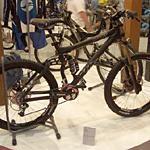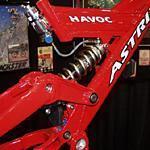
|
Eurobike EICMA Bicycling Australia Show Cycle 2003 Interbike Japan |
| Eurobike
pics EICMA pics Bicycling Australia pics Cycle 2003 Interbike Japan |
Recently on Cyclingnews.com |
Interbike 2003
Las Vegas, USA, October 10-14, 2003
Interbike round-up #3: Mountain bikes
Now the show season is over it's time to take a broader look at what the bike industry has in store for us in 2004. In the third of a series of show round-ups, Paul Mirtschin examines the directions that mountain biking is heading in.
Interbike 2003 will not be remembered for any major innovations in the mountain bike world, but it will be remembered as a show full of refinements. Stand after stand was filled with lighter, stronger or cheaper versions of existing products, ensuring that almost everyone will be able to find an excuse to upgrade last years model.
The two areas that received the most attention from the crowd were long-travel trail bikes and the addition of carbon fiber elements to cross-country bikes; the former aimed at those who want a bike to do everything on, and the latter aimed mostly at the "racers only" crowd.
Carbon cross country
 |
At one end of the scale, a number of companies were showing off lightweight, composite frames, built for the XC weenie and gear-freak alike. Taking a page from the road world, most companies were showing off models with carbon stays, carbon sub-frames or in a few cases, complete carbon frames; and they weren't all hardtails either.
Giant Bicycles has taken the bull by the horns and released both a carbon stay hardtail and an almost completely carbon framed full-suspension bike. The Giant XTC 1 hardtail mates up an ALUXX SL alloy front triangle with a carbon composite rear, while the XTC NRS Air features a carbon composite mainframe and rocker arm. Giant claim that the NRS Air loses half a kilogram in weight with the use of carbon. Giant has also redesigned the rear suspension to increase stiffness, as well as fitting a Fox Racing AVA air shock that has been valved especially for the NRS suspension.
Bianchi are better known for its road bikes, although Team Motorex Bianchi did manage to have the second best male rider in the UCI World ranking for 2003. For 2004, Bianchi will release the Oetzi XL Carbon, a lightweight carbon monocoque hardtail named after Oetzi, the 5,300 year old iceman found in the Italian Alps in 1991.
Gary Fisher has added a new model to its range of bikes, increasing the number that now come with carbon stays. The five-inch travel Cake One, Two and Three all feature carbon seatstays on its single pivot swingarm, while the Sugar Race and both Sugar 29'er models also feature carbon seatstays. Fisher claims his Cake is the lightest and most efficient five-inch travel bike on the market.
All day, every day
Almost every bike company now has at least one model of what is being called a trail bike. Sitting between the full suspension XC bike and the freeride bikes, these bikes are designed to allow the rider to do almost anything; light enough to climb up hills, and strong enough and with enough suspension to tackle most of the drops you will encounter on your all day rides with friends.
Orbea's entry into the trail bike market is the Rallon, a variable travel, disk-only frame that comes in at just 2.8 kilograms. The Rallon uses Orbea's FitFast system, allowing suspension travel and geometry to be adjusted with a quick flip of a quick-release lever. Five different positions can be used, varying the geometry by two-degrees, while changing the suspension and bottom-bracket height by around an inch.
 |
Giant has two bikes in this category, the more downhill orientated AC series, and the lighter VT series. Both offer variable travel, with the AC's rear travel at 5.3 or 6.3 inches, and the VT's at either 5 or 5.75 inches. Both bikes use Manitou's SPV equipped shocks to minimize pedal-bob.
Until recently, long-travel bikes of six-inches of travel or more were deemed to be a downhill or freeride option only; there were very few people silly enough to try to ride them uphill. However, with the boom in shock technology that has virtually eliminating pedal induced bob, mountain bikers have been moving across to longer travel frames built up with lighter weight components.
Foes Fabrications, a company better known for its ten-inch travel Mono DH, has met the needs of these riders with its Inferno, a 7.5-inch travel single-pivot frame weighing in at just 3.5 kilograms for the 17-inch frame. Fitted with the Curnutt XTD (External Threshold Damping) rear shock, the Inferno can indeed be pedaled uphill, as those trying out the bike at Interbike's DirtDemo found out.
The Inferno's monocoque frame also has a flame design embossed into it, ensuring that no one will fail to notice what bike you are riding.
 |
Astrix Sports has also entered the market with a bang with the 7.5-inch travel Huckster. Using the parallel linkage inspired PCS suspension design, Astrix claim that pedal forces are neutralized minimizing pedal bob. The Manitou Swinger shock, with its Curnutt developed Stable Platform Valve, eliminates any remaining pedal bob, allowing you to grind your way up that hill.
The same PCS suspension design is used on the Astrix Havoc, the Huckster's big brother.
Downhill, with a little bit of climbing
Heading away from the all-day trail bikes, and into the "you can pedal it uphill if you want, but it will hurt" arena, we come across the Intense M3. Designed as an update to the ten-year-old M1, the M3 achieves 9.5-inches of travel with the VPP (Virtual Pivot Point) suspension design.
 |
The VPP design allows Intense to build up a long-travel downhill frame, which can still be pedalled strongly with minimal pedal-bob. This is becoming a much-needed feature with more and more World Cup courses having flat or short uphill sections.
Originally designed by Outland, the VPP design patent was bought by Santa Cruz, who then licensed the design to Intense, with Intense owner Jeff Steber helping Santa Cruz with modifications to the VPP design. Confused?
Intense have used the VPP design on a number of its recent models, including the 4-inch travel Spider XVP and the 5.5-inch travel, and aptly named, 5.5 EVP. With the release of the M3, Intense will finally give the Santa Cruz V10 a run for its money, with an almost identical VPP suspension on both bikes.
Two bikes that will not see too many hills are the Sinister R9 and the Specialized Demo9. While both bikes share the same amount of suspension travel, both bikes are designed for very different applications.
 |
Sinister are fairly new on the scene, coming together in December of 2000 to build and sell bikes that the company couldn't break. May of 2002 saw the Sinister kick into top gear when Frank Wadelton, or Frank The Welder as he is better known, joined the team.
Frank The Welder has a long and colourful history, working for and with companies such as Onza, Shimano, Answer and Yeti, both as a welder and prototype designer. While working for the now defunct Spooky Cycles, Frank developed the FTW Linkage, a pseudo 4-bar linkage, for the Spooky Motorhead. Nine revisions later, and the R9, with nine-inches of travel, was born.
The R9 has a few interesting features that make is stand out from the rest, the first of which is its built-in rubber fork stops designed to stop the upper stanchions from crushing the frame in a crash. It is also designed to run any mix of 24 or 26-inch wheel sizes, allowing the geometry of the bike to be altered dramatically.
The R9 is not for everyone, with only one size being manufactured; a 23.5 inch top tube medium frame if you are interested.
 |
The Specialized Demo9 is a confusing bike to look at when you first see it; the jumble of linkages and tubing making you look twice to try to work out what is what. It's on the second look that you realize how it all works.
For the Demo9 suspension, Specialized's engineers have combined the proven FSR suspension design with a single-pivot style sub-seat stay actuated shock. Moving the shock away from the linkages allow the Demo9 to achieve its nine-inches of travel easily, something that would have required longer chain stays than the 16.7-inch chain stays used.
The Demo9 really has but one job in life, to take big hits, and with a RRP of US$5200 for the Demo9 DH, there will not be too many people financial enough to afford it. But those who can pony up the money to take delivery of one of these will know they have a solid ride.
The Demo9 comes built up for either downhill racing or freeriding, and is also available as a frame-only with a RRP of US$2,710.
Photos
Images by Robert Gilbreath/Cyclingnews
- Looking mean; the Astrix Havoc
- A closer look at the Havoc's swingarm
- A few Foes on display
- The Giant AC1 freeride bike
- A long awaited update to the M1; the Intense M3
- The Santa Cruz V10 with 255mm of rear travel
- Sinister DH bike built by Frank The Welder
- The mayhem that is the Specialized Demo9 DH rear
- Another look at the Demo9
Images by Jonathan Devich/ epicimages.us
- Manitou's Swinger shock with remote reservoir
- Lots of carbon on Giant's new NRS Air
- Manitou's SPV technology is getting into everything
- Gary Fisher goes bush
For a gallery of thumbnails of these pictures click here
